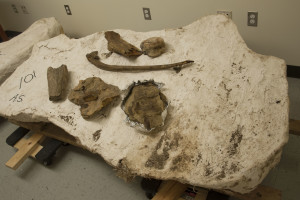
CARA MANNINO
Michelle Peterson/Winonan
Winona State University does not house dinosaurs yet, but it is close. A fossil lab was added over the summer to Pasteur 106, housing large plasters of fossils from a hadrosaurus, commonly known as a duck-billed dinosaur, ready to be prepared.
William Beatty, a geology professor, was the driving force behind creating the lab.
“We want to get students involved in the whole process of dinosaur paleontology,” Beatty said. Over the next few years, Beatty said he hopes to assemble an entire skeleton of the Hadrosaurus.
Tia Troy, a senior studying physics education, said, “Fossils are one of those things people are excited about even though they don’t know anything about them.” Troy is one of several students working in the lab this semester.
Beatty wanted the lab in a public space so people can easily see the fossils. After renovations, the lab will display the fossils with a monitor explaining the type of fossils, and where they came from.
Toby Dogwiler, professor and chair of the geology department expressed the importance of having hands-on experiences, which is what the fossil lab provides.
“In the current job market, it is imperative that students leave college having demonstrated hands-on experience, applying the knowledge from their field of study,” Dogwiler said, “the fossil lab is yet another way that Winona State students can gain [that] experience in the geosciences.”
The geology department offers two courses in paleontology that are open to students of all studies: the first is an introduction course, the second is a travel study to Marmarth, N.D., which is the same place the hadrosaur fossils were found. Beatty said that Marmarth is also known to have bones from a tyrannosaurus rex and a triceratops. Students will discover bones, extract them and prepare them for display.
The process of discovering dinosaur bones is different from what we see in movies. When paleontologists discover dinosaur bones, they stop digging and pour plaster around the area. Then they dig under the bone, roll it over and plaster the bottom of the area. This allows for easier travel, since the bones are fragile.
Once the plastered pieces are at the lab, sudents cut the plaster and clear away rock and dirt to reveal the fossils. They add a glue-like solution to the fossils that fills in pores to make the bones more durable.
Paleontologists often work with small pieces of a bone that fit together like a puzzle.
“This is an opportunity that most undergraduates don’t get. Even most graduate students don’t get to touch any fossils in the field,” JoHannah Heller, a senior studying life science education, said. Heller is also working in the lab this semester.
Not only will the lab be beneficial to Winona State students, but also for other Winona schools. Dr. Charla Miertschin said the lab is sure to interest children because dinosaur fossils are not something they typically get to see in person.
The lab will be a great addition to the Middle School Science Day this spring, which teaches 8th grade students about many areas of science.
The lab will be ready for public viewing in early September.
Contact Michelle at [email protected]




























































